Kaizen #127 - Circuits in Zoho CRM - Part 2
Hello everyone!
We're back with part 2 of Circuits in Zoho CRM!
We are as excited as you are with this topic! Let's dive right in!
As promised, in today's post, we will discuss a use case, see how execution happens, and associate that circuit with a workflow.
In our next post(Yes! There's going to be another one!), we will associate the circuit with a button and a blueprint, view logs, and debug issues.
Sample use case - Loan Verification Process
Consider that we have a module in CRM called Customers, where we have personal information of customers, tax-related details, tax and personal ID verification details and status. Our aim is to check the requested loan amount, check eligibility, and then grant or reject it.
Here is a screenshot of a record in the Customers module.
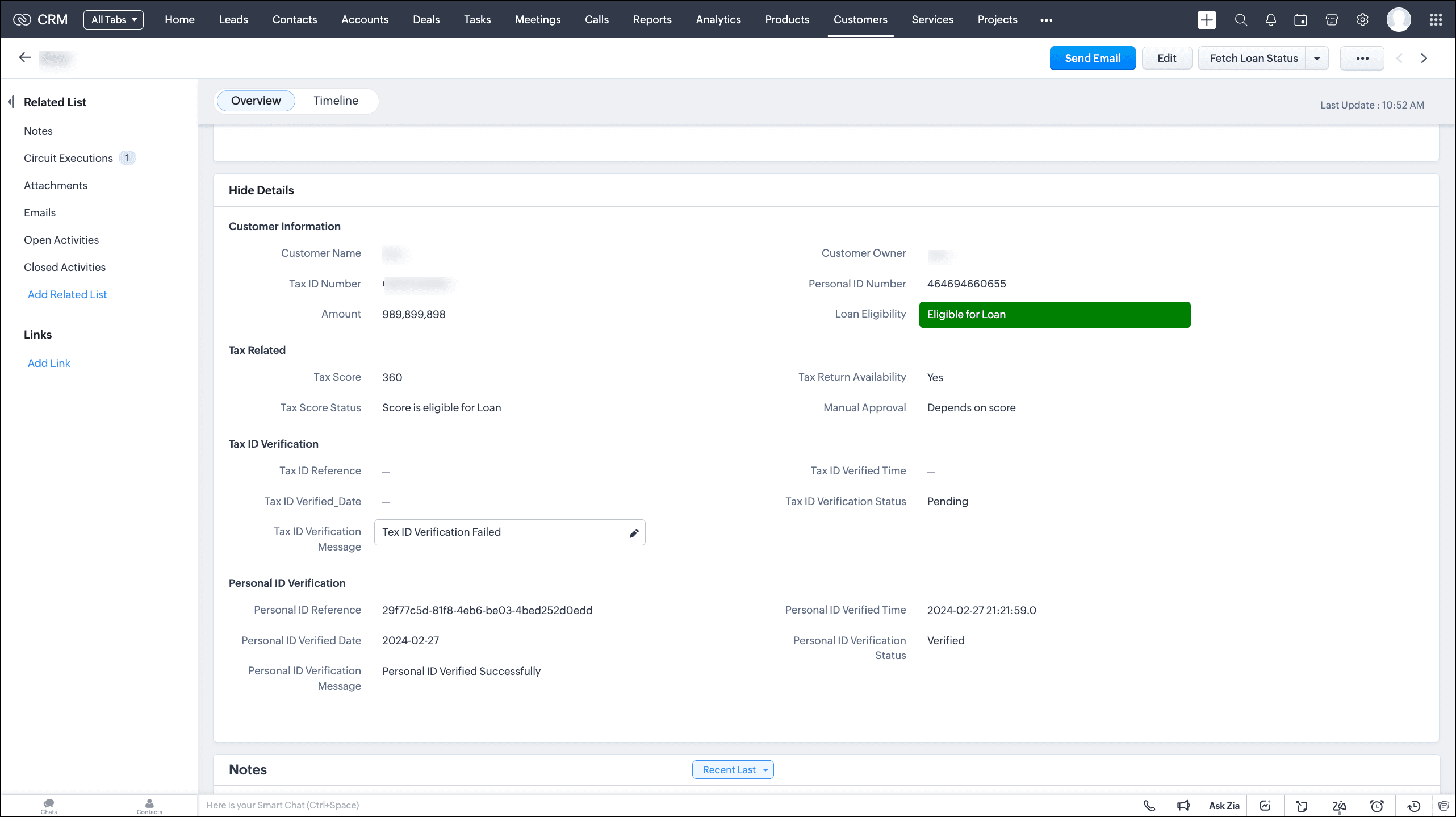
Our condition is that whenever the loan amount is less than Rs. 500,000, the circuit should directly proceed to document verification. When the requested loan amount is greater than Rs. 500,000, we must check a few eligibility criteria before proceeding to document verification.
We can automate this entire process using Circuits, and execute it through a button, associate it with a workflow or a blueprint.
Let's take a look at the Circuit's flow.
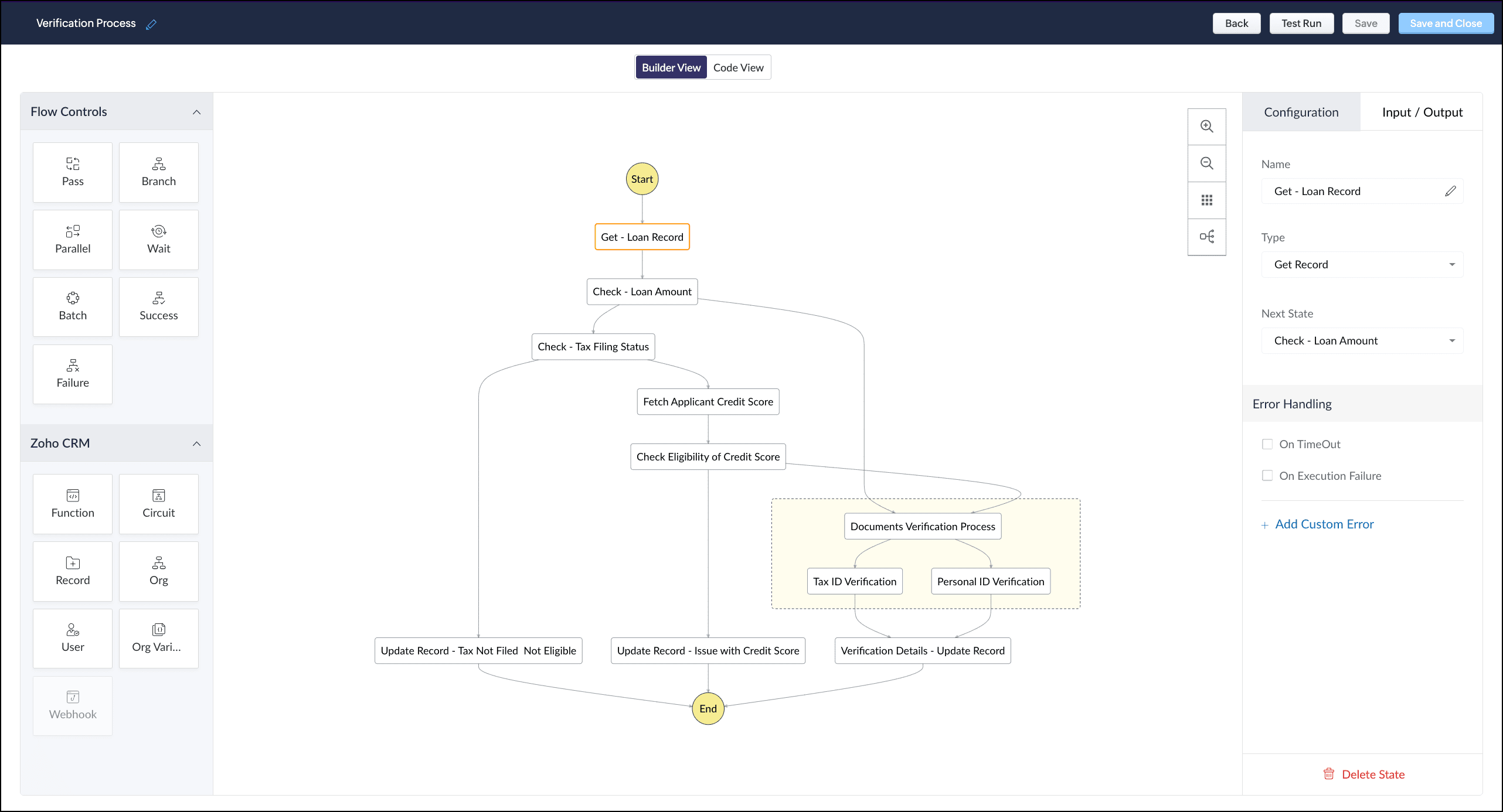
Here are the different states of the Circuit that explain the logic.
- Get the loan record.
- Check the loan amount.
- If the loan amount is less than Rs. 500,000, proceed to document verification.
- If the loan amount is greater than Rs. 500,000, check the tax filing status.
- If tax is not filed, update the record's Loan Eligibility field with the value "Tax not filed. Hence, not eligible for loan".
- If tax is filed, fetch the applicant's credit score and check the eligibility.
- If the credit score falls short, update the record's Loan Eligibility field with the value "Issue with credit score".
- If the credit score is up to the mark, proceed to document verification—Personal ID and Tax ID verification.
- Update the details of the record to sanction the requested loan.
Let's discuss each of these states in detail.
1. Get the loan record
Builder View

Type: Get Record from Zoho CRM's states.
Action: Gets the details of the loan record from the Customers module. The output is in the following format.
{ "ZohoCRM": { "record_id": "5575270000005762031", "user_id": "5575270000005379053", "module": { "api_name": "Customers", "tab_label": "Customers", "id": "5575270000001975002" } }, "record": { "data": [ { "Owner": { "name": "Patricia Boyle", "id": "5575270000001947001", "email": "p.boyle@zylker.com" }, "$currency_symbol": "$", "Tax_ID_Verification_Message": "Tax ID Verified Successfully", "$review_process": { "approve": false, "reject": false, "resubmit": false }, "$sharing_permission": "full_access", "Personal_ID_Number": "464694660655", "Personal_ID_Verification_Message": "Personal ID Verified Successfully", "Name": "Stephen Adams", "Manual_Approval": "Depends on score", "$state": "save", "$process_flow": false, "Tax_Score_Status": "Score is eligible for Loan", "$locked_for_me": false, "Tax_ID_Number": "GBHPS3618H", "id": "5575270000005762031", "Tax_ID_Verified_Date": "2024-02-26", "Loan_Eligibility": "Eligible for Loan", "$approval": { "delegate": false, "approve": false, "reject": false, "resubmit": false }, "Modified_Time": "2024-02-29T12:26:11+05:30", "Tax_ID_Verification_Status": "Verified", "Tax_Return_Availability": "Yes", "Tax_ID_Verified_Time": "2024-02-26 23:28:39.0", "Personal_ID_Verified_Time": "2024-02-26 23:28:39.0", "Created_Time": "2024-02-29T12:26:11+05:30", "Amount": 600000, "$editable": true, "Personal_ID_Reference": "6cefa3d4-b87b-46a6-8814-b21fb422a28d", "$orchestration": false, "Tax_ID_Reference": "f6697aa8-8efc-4ee9-8dcc-0bc838755cb4", "Tax_Score": 450, "Personal_ID_Verification_Status": "Verified", "Personal_ID_Verified_Date": "2024-02-26", "$in_merge": false, "Locked__s": false, "Tag": [], "$zia_owner_assignment": "owner_recommendation_unavailable", "$approval_state": "approved", "$pathfinder": false } ] } } |
You can use any part of this output as input to other states. You can achieve this by using the JSON Path expression in the “result path” to traverse the result JSON of the state.
Result path allows you to combine state result with state input to pass as output. You can add the result path in the "Input/Output" section in the Builder view as well as the JSON in Code view.

In our case, we want to use the data inside the “record” JSON object. So, the result path will be $.record.

Result path is mandatory when you use the Get Record Zoho CRM state.
Next state: Check Loan Amount
Code View

2. Check Loan Amount
Builder View
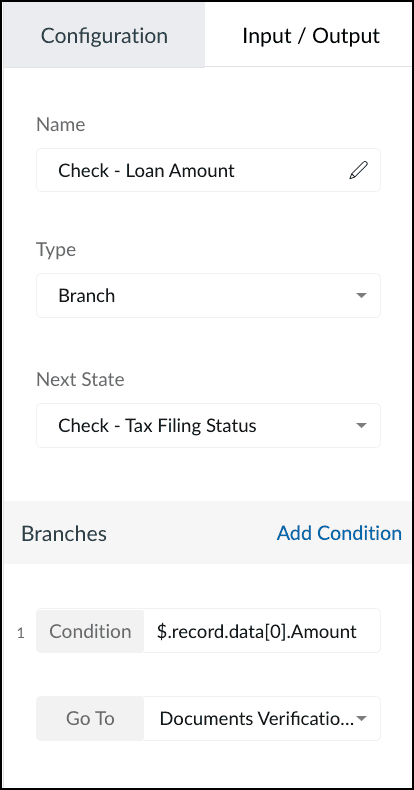
Type: Branch
Action: Checks for the condition specified in the branch—check if the loan amount < 500,000. If yes, and Go to Documents verification state, else go to Check tax filing status state.
Next state: Check Tax filing status(if loan amount > 500,000)
Code View
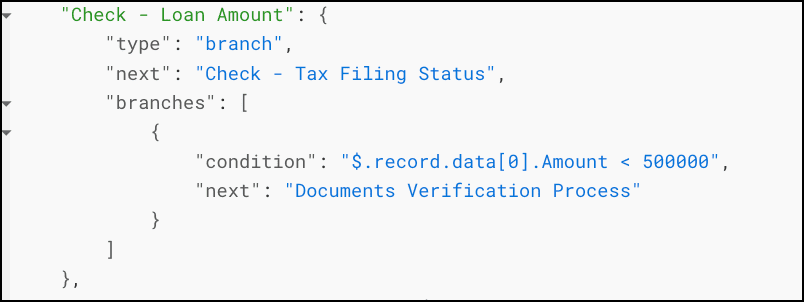
3. Check Tax Filing Status
Builder View

Type: Branch
Action: Checks for the condition specified in the branch—if the tax filing status is Yes, fetch the credit score. Else, update the record with "Tax not filed; not eligible for loan".
Next state: Fetch Applicant Credit Score
4. Fetch Applicant Credit Score
Builder View
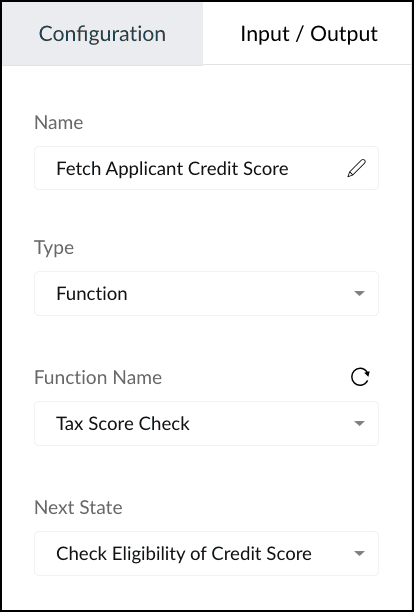
Type: Function
Action: Executes the CRM function "Tax Score Check" that holds the logic to get the basic eligibility stored in the Org variable "eligibility", compare it with the tax score of the applicant, and update the record, accordingly. Here is the snippet of this function.

Next state: Check eligibility of Credit Score
Code View

5. Check eligibility of Credit Score
Builder View
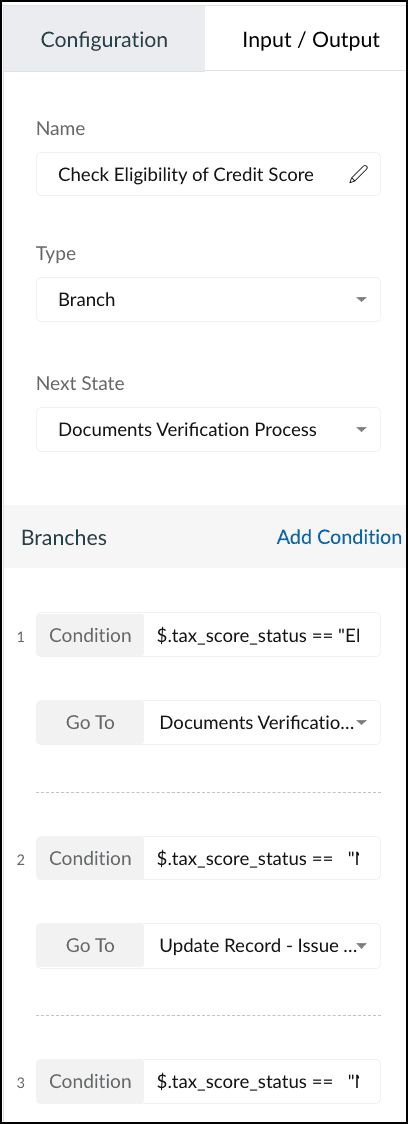
Type: Branch
Action: Checks for multiple conditions—if Tax Score Status = Eligible, go to Document Verification.
If Tax Score Status = Not eligible & the value of the field "Manual Approval" = "Not approved", update the record with "Issue in Tax Score".
If Tax Score Status = Not Eligible & "Manual Approval" = "Approved", proceed to document verification.
Next state: Depends on the condition that is met in the "Check Tax Score Eligibility" state.
Code View
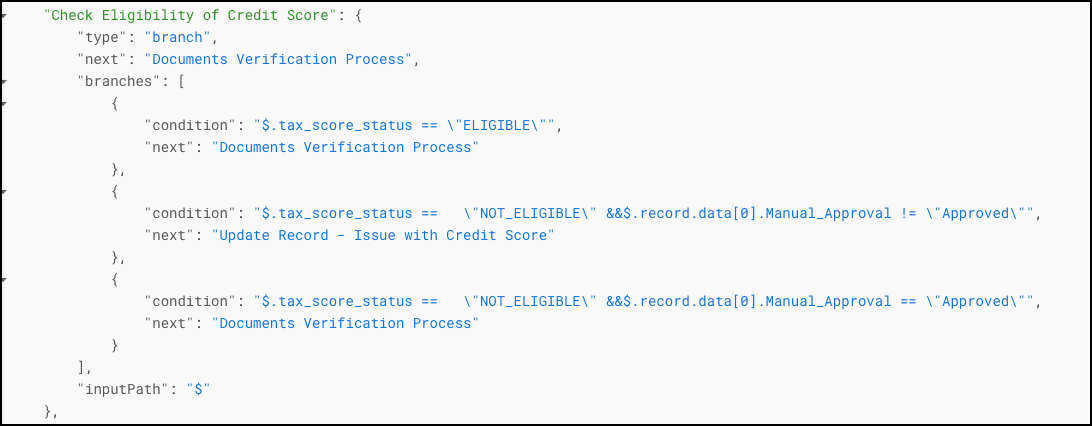
6. Documents Verification Process
Builder View
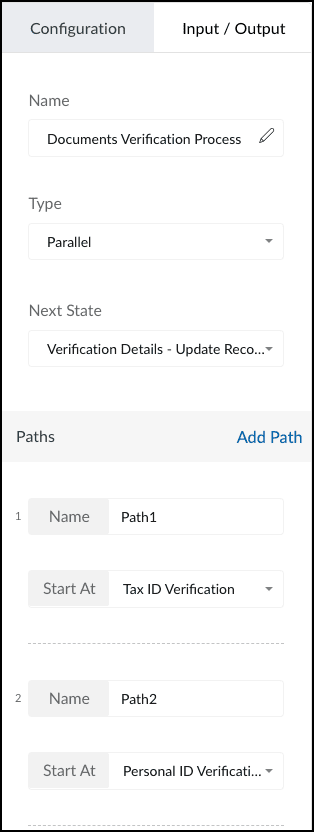
Type: Parallel
Action: Verifies the Tax ID and Personal ID of the applicant.
Next state: Verification Details - Update Record
Code View
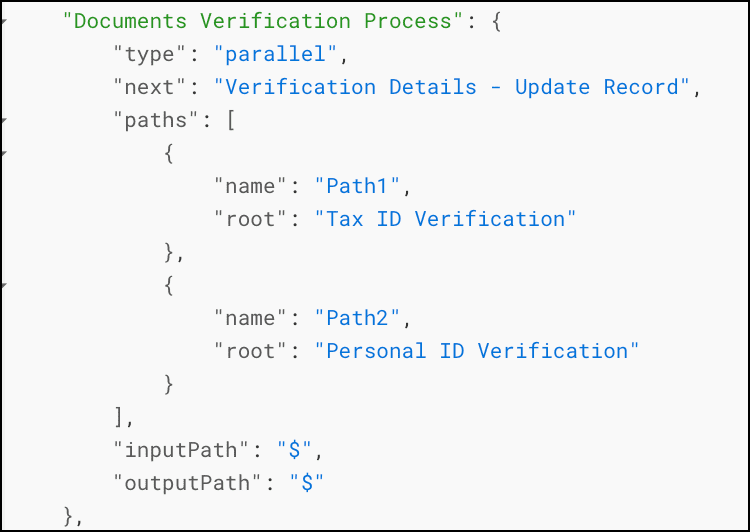
7. Tax ID Verification
Builder View

Type: Function
Action: Executes the function "Tax ID Verification" that has the logic to verify the tax details of the applicant.
Here is the snippet of this function.
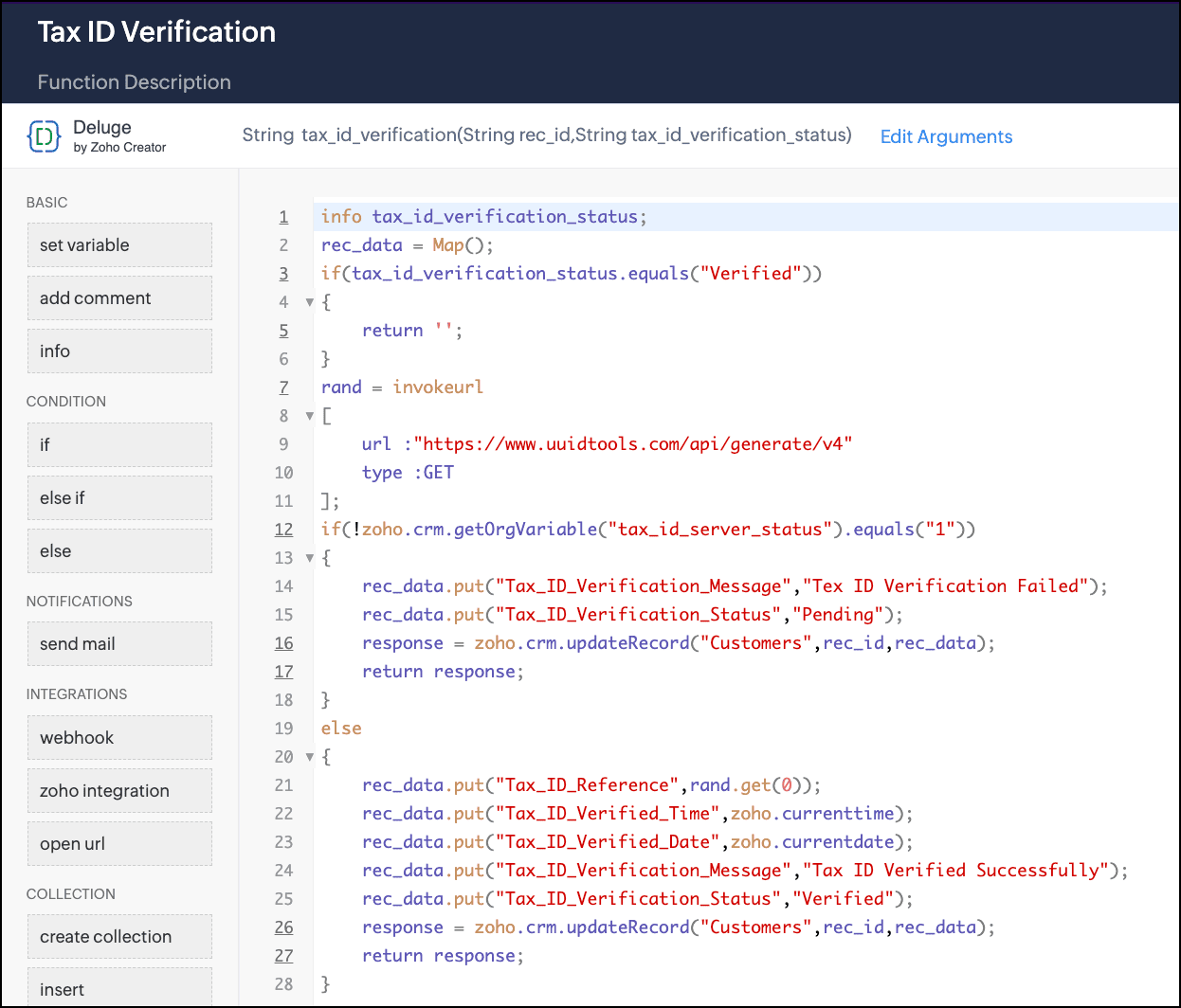
Next state: Verification Details - Update Record
Code View
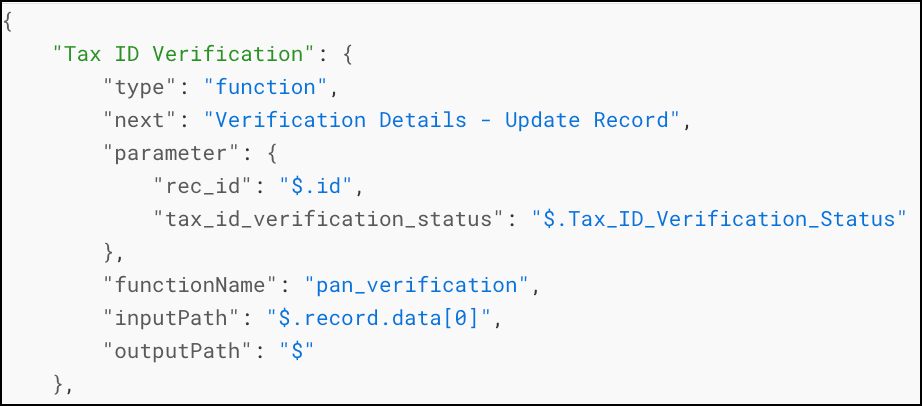
8. Personal ID Verification
Builder View

Type: Function
Action: Executes the function "Personal ID Verification" that has the logic to check for the applicant's personal details.
Here is how the function looks.

Next state: Verification Details - Update Record
Code View

9. Verification Details - Update Record
Builder View

Type: Function
Action: Executes the function "Update Customer Record status" that uses the Deluge Update Record integration task to update the "Loan eligibility" field.
Here is how the function looks.

Next state: End
Code View
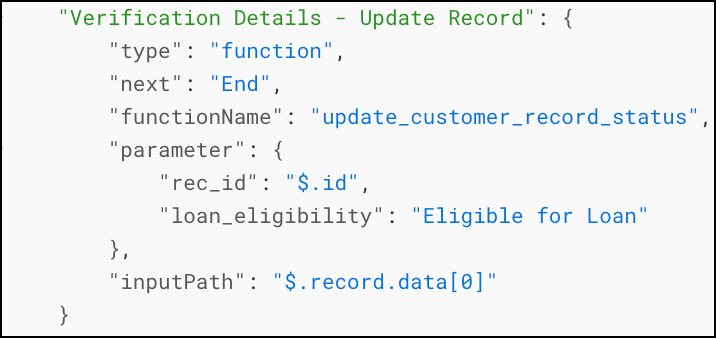
10. Update Record - Tax Not Filed, Not Eligible
Builder View
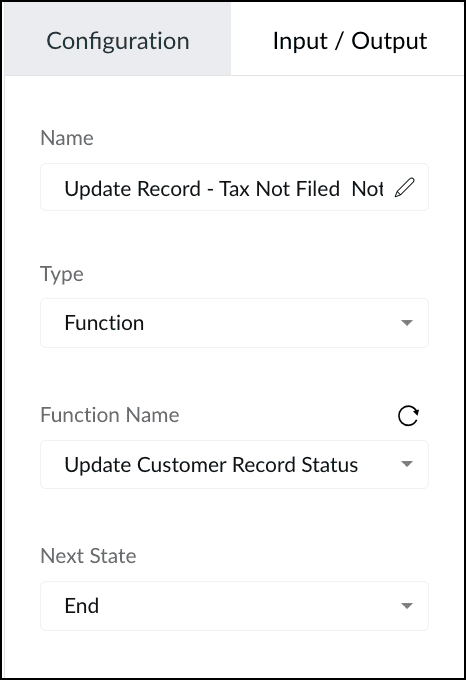
Input/Output

Type: Function
Action: When the requested loan is greater than Rs.500,000 and the Tax Filing Status in "Not Filed", this state executes the function "Update Customer Record status". This function uses the Deluge Update Record integration task to update the "Loan eligibility" field, and takes the parameters "rec_id" and "loan_eligibility" with the values "$.ZohoCRM.record_id" and "Tax Filing is missing, Hence not eligible for the loan.", respectively.
Next state: End
Code View

11. Update Record - Issue with Credit Score
Builder View

Type: Pass
Action: When the tax score eligibility does not meet the requirement, this state ends the circuit's execution.
Next state: End
Code View

Testing and Execution
Let us see the execution of this circuit with a sample record ID.
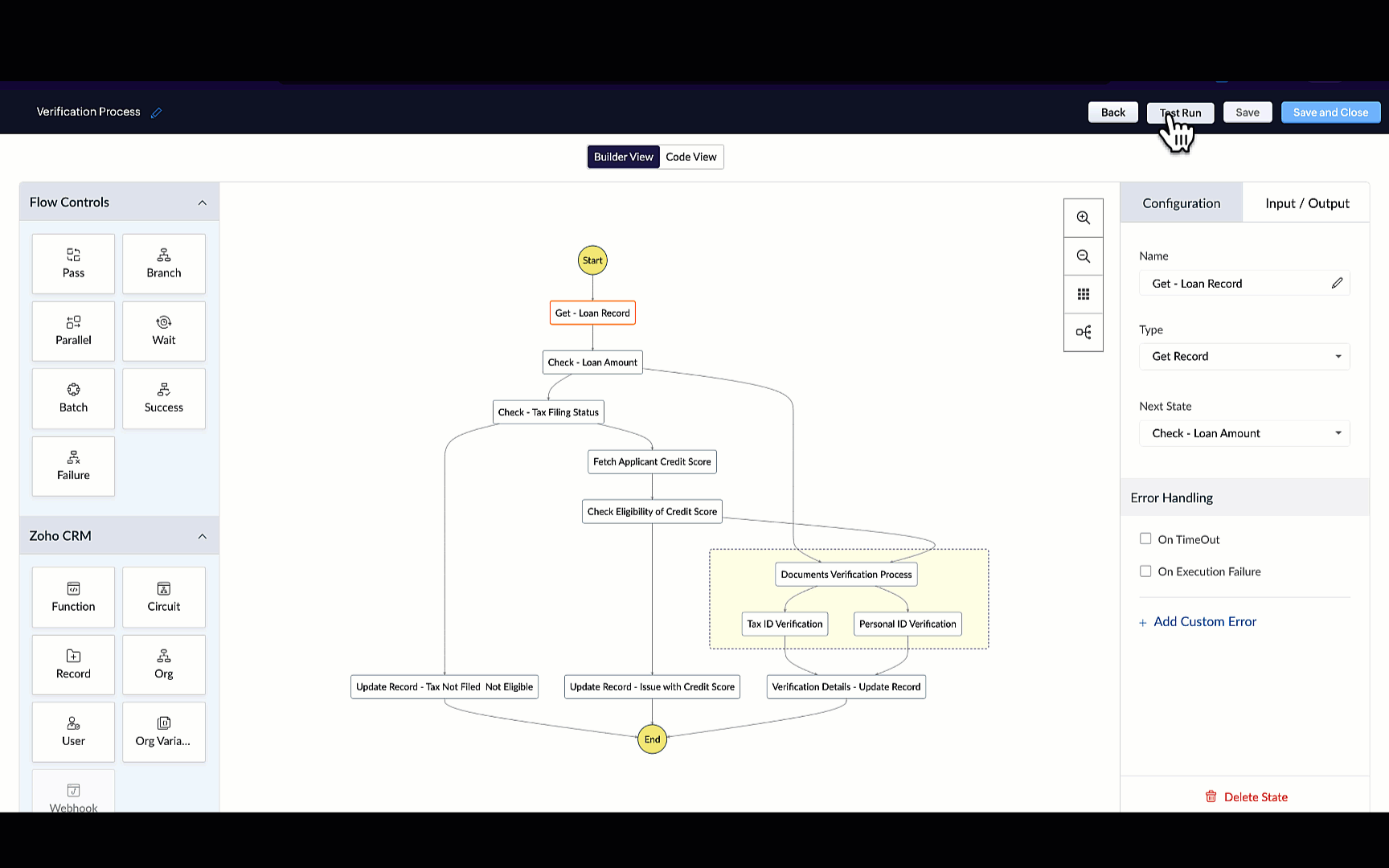
When you click each state, you can see the input and output of that state.
When you click "View Logs", you can see how execution has happened, the payload for each state, the response, etc.
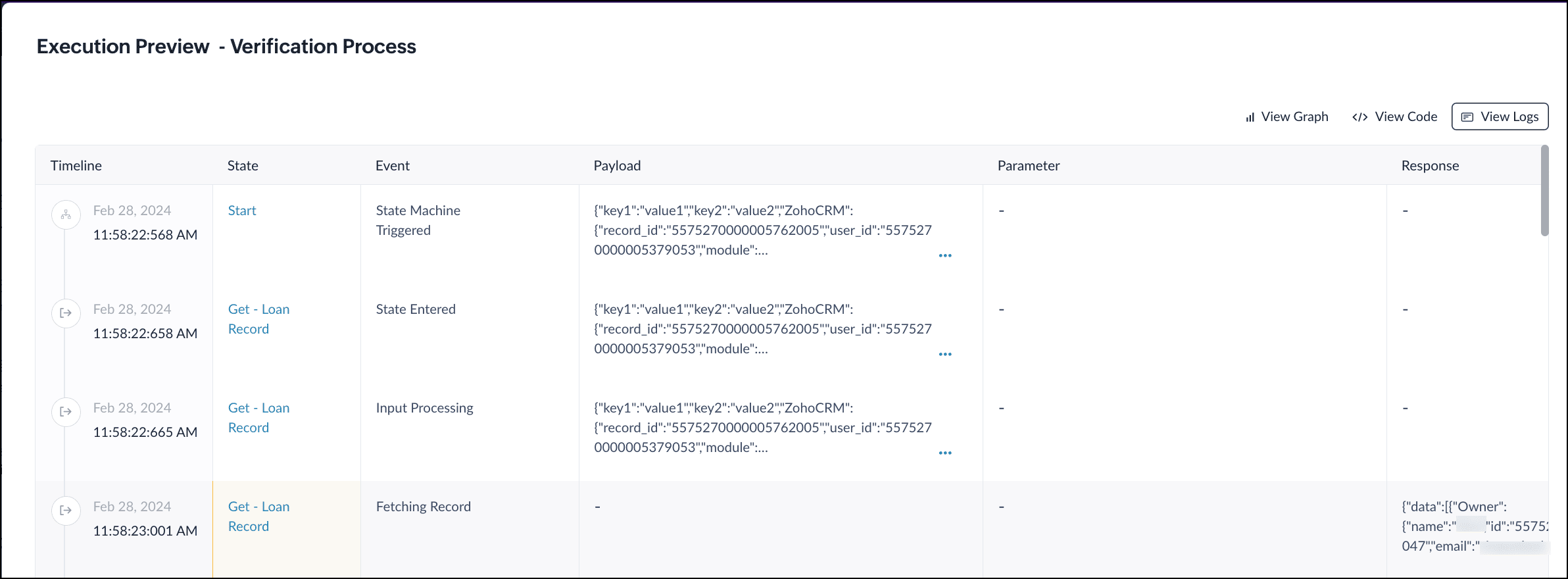
Associating this Circuit with a Workflow
Follow the steps mentioned in this article to create a workflow.
The condition for this workflow to execute the circuit is when the requested loan is greater than Rs. 500,000.
The Action is to execute the circuit. Choose the option "Execute Circuit" from the Instant Actions and select the Verification Process Circuit.
Save the workflow.
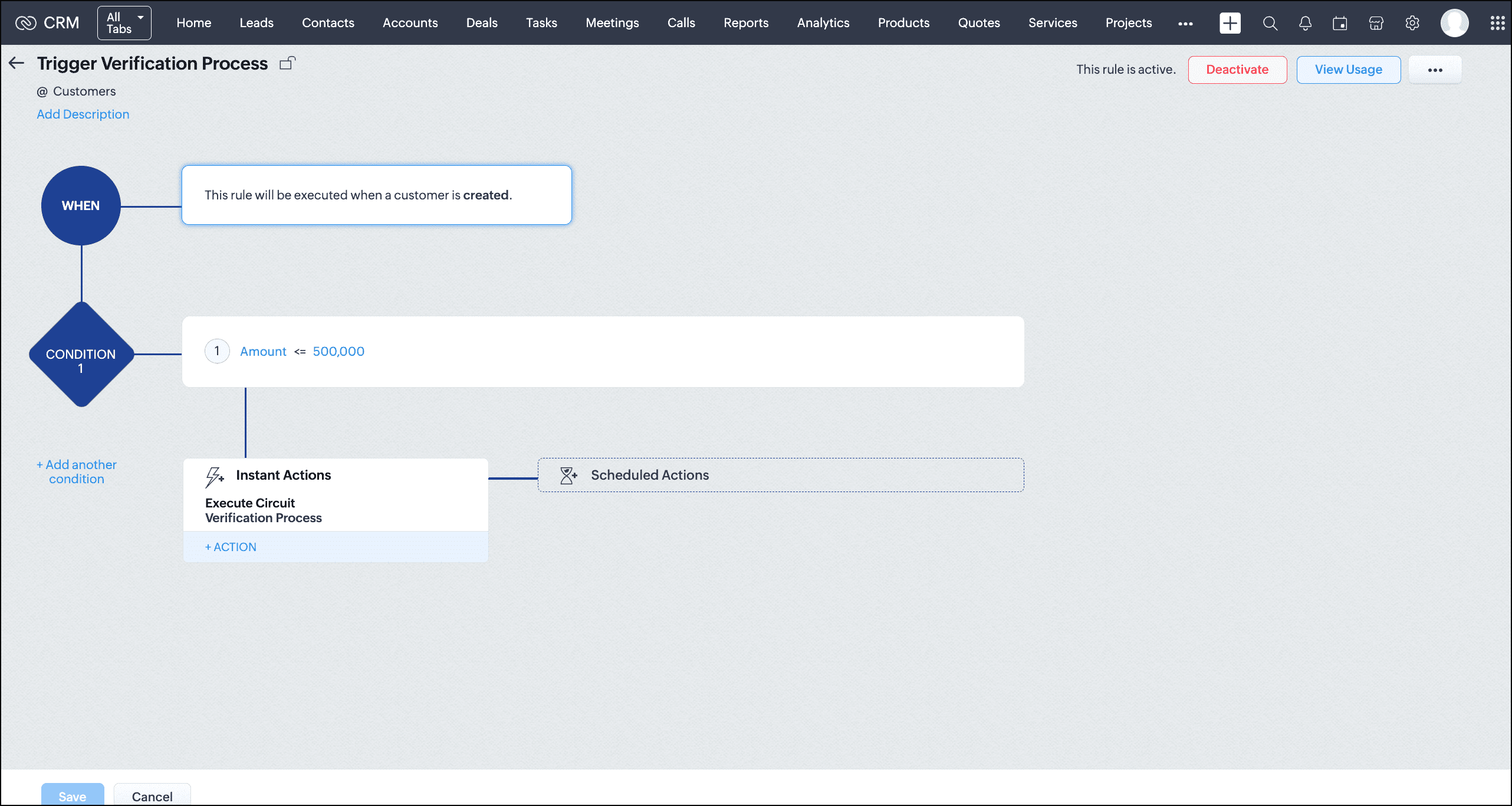
Let's test this workflow by creating a record in the Customers module with the loan amount less than Rs. 500,000.
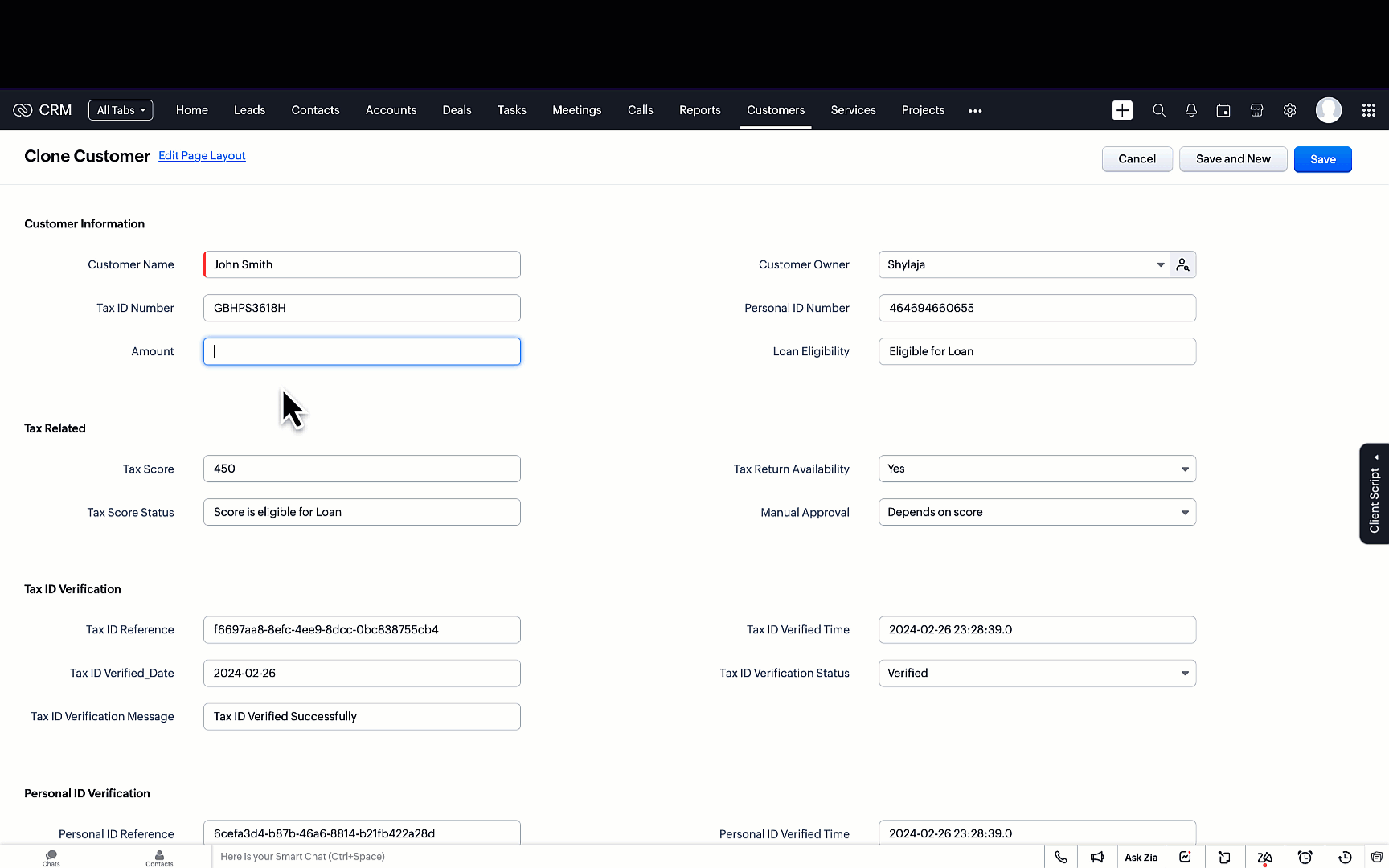
As you can see, the workflow is triggered and executes the circuit when the loan amount is less than Rs. 500,000.
You can view the circuit's execution and other details as a related list.
Summary
Circuits allow you to automate entire business processes by allowing you to orchestrate functions along with your business logic as you see fit.
As you witnessed in this example, we used multiple independent functions written in CRM to achieve our business case through utilizing them in a circuit. This gives you the benefit of writing functions that can be reused in multiple places while saving you from the grief of dealing with huge volumes of code that are hard to maintain and harder to debug when written as a single function.
We hope you liked this post. We'll see you next week with another post on Circuits.
Let us know if you have any questions or feedback. We are listening!
Cheers!
Shylaja S
Additional Reading:
New to Zoho Recruit?
Zoho Developer Community
New to Zoho LandingPage?
Zoho LandingPage Resources
New to Bigin?
Topic Participants
Shylaja S
Sticky Posts
Kaizen #222 - Client Script Support for Notes Related List
Hello everyone! Welcome to another week of Kaizen. The final Kaizen post of the year 2025 is here! With the new Client Script support for the Notes Related List, you can validate, enrich, and manage notes across modules. In this post, we’ll explore howKaizen #217 - Actions APIs : Tasks
Welcome to another week of Kaizen! In last week's post we discussed Email Notifications APIs which act as the link between your Workflow automations and you. We have discussed how Zylker Cloud Services uses Email Notifications API in their custom dashboard.Kaizen #216 - Actions APIs : Email Notifications
Welcome to another week of Kaizen! For the last three weeks, we have been discussing Zylker's workflows. We successfully updated a dormant workflow, built a new one from the ground up and more. But our work is not finished—these automated processes areKaizen #152 - Client Script Support for the new Canvas Record Forms
Hello everyone! Have you ever wanted to trigger actions on click of a canvas button, icon, or text mandatory forms in Create/Edit and Clone Pages? Have you ever wanted to control how elements behave on the new Canvas Record Forms? This can be achievedKaizen #142: How to Navigate to Another Page in Zoho CRM using Client Script
Hello everyone! Welcome back to another exciting Kaizen post. In this post, let us see how you can you navigate to different Pages using Client Script. In this Kaizen post, Need to Navigate to different Pages Client Script ZDKs related to navigation A.
New to Zoho TeamInbox?
Zoho TeamInbox Resources
Zoho CRM Plus Resources
Zoho Books Resources
Zoho Subscriptions Resources
Zoho Projects Resources
Zoho Sprints Resources
Qntrl Resources
Zoho Creator Resources
Zoho CRM Resources
Zoho Show Resources
Get Started. Write Away!
Writer is a powerful online word processor, designed for collaborative work.
Zoho CRM コンテンツ
-
オンラインヘルプ
-
Webセミナー
-
機能活用動画
-
よくある質問
-
Ebook
-
-
Zoho Campaigns
- Zoho サービスのWebセミナー
その他のサービス コンテンツ
Nederlandse Hulpbronnen
ご検討中の方
Recent Topics
How do I bulk archive my projects in ZOHO projects
Hi, I want to archive 50 Projects in one go. Can you please help me out , How can I do this? Thanks kapilZOHO Work Drive Back Up
I am looking for a ZOHO Work Drive backup solution. Something that is cloud based. There's lots of these kinds of options for Google Drive and other providers, but I have not seen anything for WorkDrive. Any suggestions?ZOHO Reports - Filter Logic?
Hi, I need a way to apply filter logics such as ((1 AND 2) OR 3). All I can see as of now is a way to enter different AND filters in the respective filter column. But how can I add an OR filter? Any advice would be highly appreciated. MarkScanned Doc - selecting Item overwrites Rate
I have a Vendor Invoice which was uploaded to Documents. I select Add To > New Bill. The OCR is actually quite good, but it is reading an Item Description instead of an Item Number. I remove the description and select the correct Item Number... and itRecruit API search
Hi all, Attempting to call the search api endpoint from Postman using the word element as mentioned in api docs Search Records - APIs | Online Help - Zoho Recruit When making the call to /v2/Candidates/search?word=Saudi receive response of { "code": "MANDATORY_NOT_FOUND",Manage control over Microsoft Office 365 integrations with profile-based sync permissions
Greetings all, Previously, all users in Zoho CRM had access to enable Microsoft integrations (Calendar, Contacts, and Tasks) in their accounts, regardless of their profile type. Users with administrator profiles can now manage profile-based permissionsNo funcionan correctamente el calculo de las horas laborales para informe de tickets
Hola, estoy intentando sacar estadísticas de tiempo de primera respuesta y resolución en horario laboral de mis tickets, pero el calculo de horas en horario laboral no funciona correctamente cree los horarios con los feriados : Ajusté los acuerdos deZoho desk desktop application
does zoho desk has a destop applicaion?Saving reading position + Keep screen on
While Zoho Notebook is excellent for saving and annotating articles, its utility is severely limited by the lack of reading progress synchronization. On the Android app, if a user exits a long note after reading 50%, the app fails to save the position.Zoho LandingPage is integrated with Zoho One!
Greetings to the Zoho One users out there! We're delighted to let you know that Zoho LandingPage is available in Zoho One too! With Zoho LandingPage, you can host custom-made landing pages, and persuade the visitors to dive deeper by making further clicks,Android app sync problem - multiple devices have same problem
Hello, I am having a problem with synchronization in the Android app. When I create a drawing, the data does not sync correctly—only a blank note is created without the drawing. I tested this on multiple devices, including phones and tablets, and theHow can i resend a campaign to only one of the recipients on the original campaign
How can i resend a campaign to only one of the recipients on the original campaign ? Sincererly, MikeNotes badge as a quick action in the list view
Hello all, We are introducing the Notes badge in the list view of all modules as a quick action you can perform for each record, in addition to the existing Activity badge. With this enhancement, users will have quick visibility into the notes associatedHow to show branch instead of org name on invoice template?
Not sure why invoices are showing the org name not the branch name? I can insert the branch name using the ${ORGANIZATION.BRANCHNAME} placeholder, but then it isn't bold text anymore. Any other ideas?Create CRM Deal from Books Quote and Auto Update Deal Stage
I want to set up an automation where, whenever a Quote is created in Zoho Books, a Deal is automatically created in Zoho CRM with the Quote amount, customer details, and some custom fields from Zoho Books. Additionally, when the Sales Order is convertedMarketing Automation Requirements Questions
I would like to set up a multi-email drip campaign- please see the structure below and confirm if I can achieve this set up in Zoho marketing automation. Where applicable, highlight gaps and workarounds. Thanks Drip email campaign- Can I create one dripSharing URLs and direct access
Hello, I am storing my team's email signature images on Workdrive. I am creating a public image download share and adding “?directDownload=true” so that the image can be accessed without the Workdrive interface. A few questions: 1) Can we generate friendlyhow to change the page signers see after signing a document in zoho sign
Hello, How can I please change the page a signer sees after signing a document in Zoho Sign? I cannot seem to find it. As it is now, it shows a default landing page "return to Zoho Sign Home". Thanks!Question about using custom_fields in Storefront Add-to-Cart API (error 2003 – required details)
Hi everyone, I’m working with the Zoho Commerce Storefront API, specifically the Add to Cart endpoint: POST /storefront/api/v1/cart According to the documentation, this endpoint supports a custom_fields parameter for adding line-item custom data. I’mCan a project be cloned?
Good afternoon, greetings. I would like to ask if it's possible to clone a project in Microsoft Project. I found a way to do it using templates, but I'm not sure if there's a direct way to clone a project. Thank you in advance for your attention, andTimesheet Tasks in Zoho Books: associate to service item
How do we associate a service item to timesheet tasks in Zoho Books? For example: Joe spent 5 hours on project:task1 which is Service Item#1 (Income:Service1). When the invoice is issued thru the Project Invoice section, this is not available. When theWhy Sharing Rules do Not support relative date comparison???
I am creating a Sharing Rule and simply want to share where "Last Day of Coverage" (Date field) is Greater than TODAY (Starting Tomorrow). However, sharing rules don't have the option to compare a date field to a relative date (like today), only to StaticTask/Activity indicator in SalesPipeline overview has disappeared
I Just logged in my ZOHO CRM first 2026 checking my salespipeline overview , Every record card used to show an indication that there was an open task (Yellow if the expiry date was close, red if the expiry date was today and grey when it had expired).Tip #56- Accessibility Controls in Zoho Assist: Hearing- 'Insider Insights'
As we begin the new year, it’s a great time to focus on making our tools more inclusive and accessible for everyone. Remote support often involves long hours in front of screens, varying lighting conditions, and users with diverse accessibility needs.JWT Token authentication problem that sometimes generates infinite redirect loops
Description : Nous proposons un bouton sur notre plateforme permettant de rediriger l'utilisateur vers le portail ZohoDesk via un jeton JWT pour une authentification transparente. Cependant, il arrive que certains utilisateurs soient pris dans une boucleZoho Desk Android app update: Table view for All Departments view, custom button
Hello everyone! In the latest version(v2.9.25) of the Zoho Desk Android app update, we have introduced Table view for the 'All Departments' view in the ticket module. We also have supported an option that allows tickets in the Table view to be sortedWhat's New - December 2025 | Zoho Backstage
In December, Backstage introduced a focused set of updates that improve how you manage registrations, communicate with attendees, and track participation. These enhancements are designed to give organizers greater flexibility and clearer control acrossNeed code format to specify default values
Can someone please direct me to the code syntax or the proper translation per the instructions circled below. These instructions don't seem correct.Add multiple users to a task
When I´m assigning a task it is almost always related to more than one person. Practical situation: When a client request some improvement the related department opens the task with the situation and people related to it as the client itself, the salesmanA Roundup of Zoho Sprints 2025
Issue with WhatsApp Template Approval and Marketing Message Limit in Zoho Bigin
We are facing issues while creating and using WhatsApp message templates through Zoho Bigin, and we request your clarification and support regarding the same. 1. Utility Template Approval Issue Until December, we were able to create WhatsApp templatesSorting Custom Date in API isn't working w pagination limit
How can we sort a custom field with DATE using pagination? Starting at page=1 then moving to page=2 with a limit of 10 each, its all messed up and even shows some of the same records as page 1? https://www.zohoapis.com/crm/v2/INVOICE_MODULE/search?criteria=(FM_Contact_ID:equals:1234)&sort_by=Invoice_Date&sort_order=desc&per_page=10&page='SAP Business One(B1) integration is now live in Zoho Flow
We’re excited to share that SAP Business One (B1) is now available in Zoho Flow! This means you can now build workflows that connect SAP B1 with other apps and automate routine processes without relying on custom code. Note: SAP Business One integrationEnhancement in Role and Profile mapping of agents in Sandbox
Hello everyone! We have brought in a modification in the way users are mapped to a particular role and profile in Sandbox. What has changed? When agents are copied from production to Sandbox: If a user's current role and profile is available in Sandbox,The reason I switched away from Zoho Notebook
My main reason for switching to Zoho was driven by three core principles: moving away from US-based products, keeping my data within India as much as possible, and supporting Indian companies. With that intent, I’ve been actively de-Googling my digitalDecimal places settings for exchange rates
Hello, We are facing issues while matching vendor payments with banking feeds. As we often import products/services exchange rate comes into play. Currently, ZOHO allows only six digits for decimal places. We feel that conversions like JPY to INR requireZoho removed ability to see all Scheduled Reports!
If you are not the owner of a scheduled report, Zoho recently removed the capability to see each scheduled report. As an admin who relies on seeing all scheduled reports being sent, this is a terrible update. Now I cannot see ANY scheduled reports...even the ones I am being sent!! This should be a setting for admins to control. This is a bad update.Please can the open tasks be shown in each customer account at the top.
Hi there This has happened before, where the open tasks are no longer visible at the top of the page for each customer in the CRM. They have gone missing previously and were reinstated when I asked so I think it's just after an update that this featureAutomate Backups
This is a feature request. Consider adding an auto backup feature. Where when you turn it on, it will auto backup on the 15-day schedule. For additional consideration, allow for the export of module data via API calls. Thank you for your consideration.GCLID and Zoho Bookings
Is there anyway to embed a Zoho Bookings signup on a landing page and pass the GCLID information? More specifically, can this be done using auto-tagging and not manual tagging the GCLID? I know Zappier has an integration to do this but is there a betterNext Page












